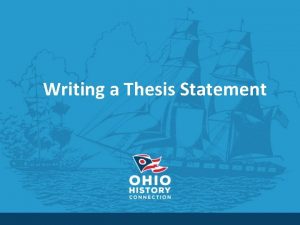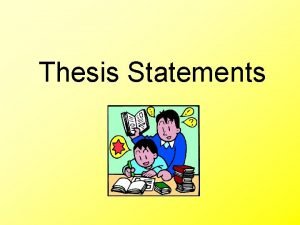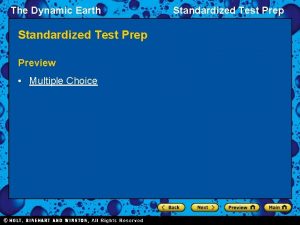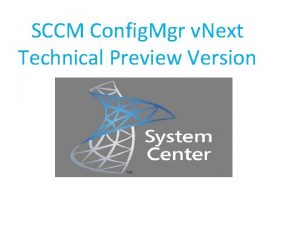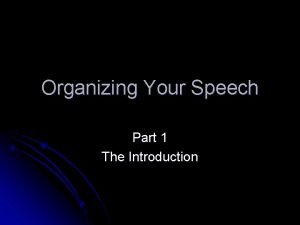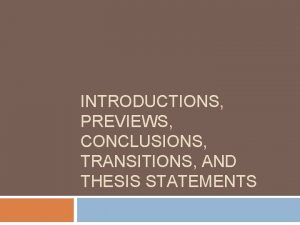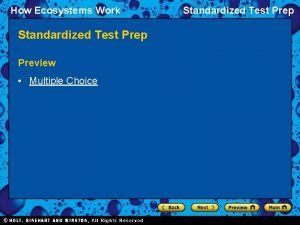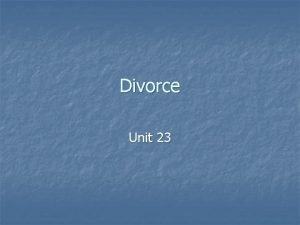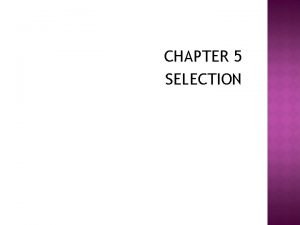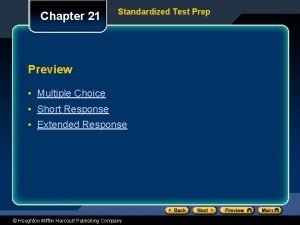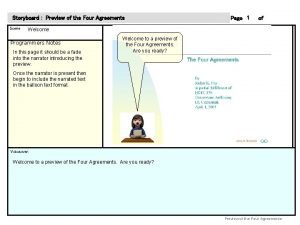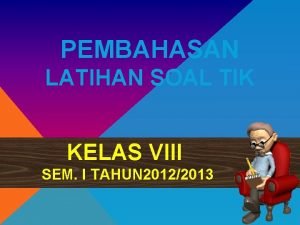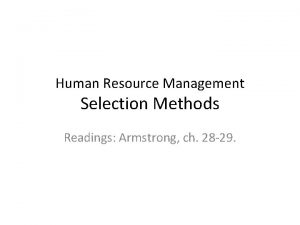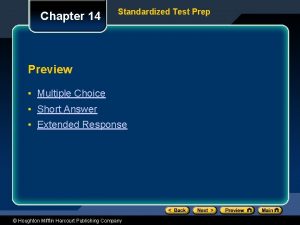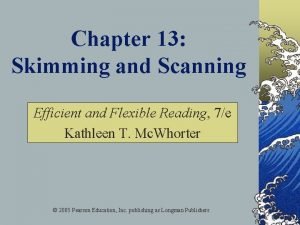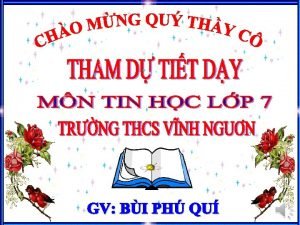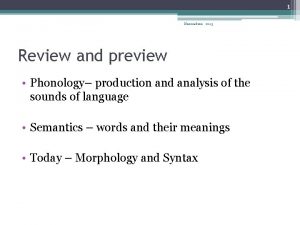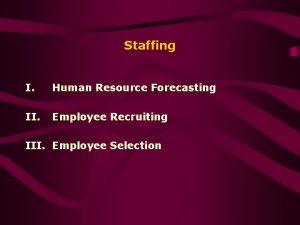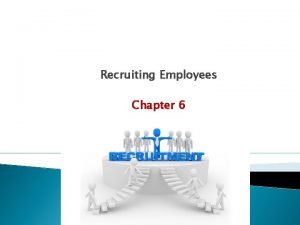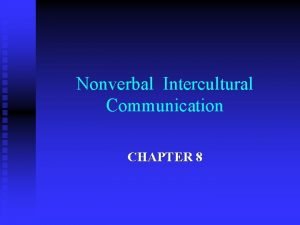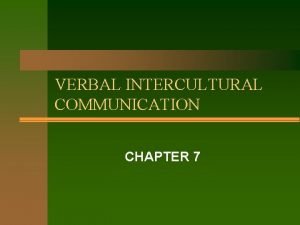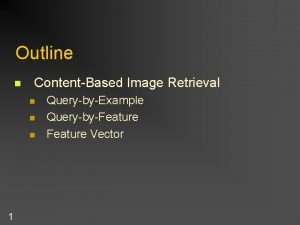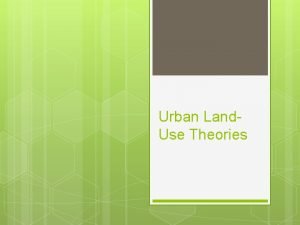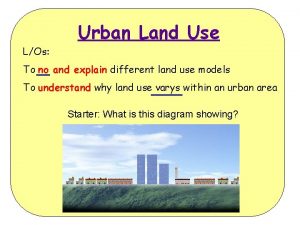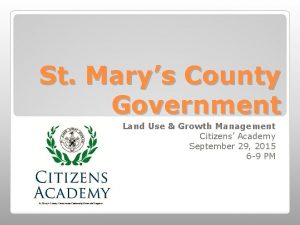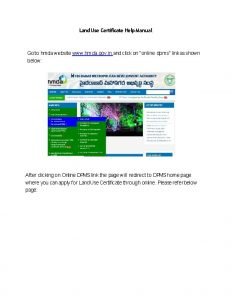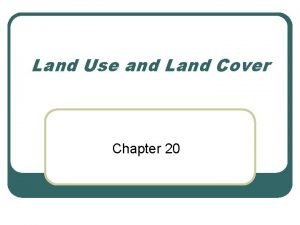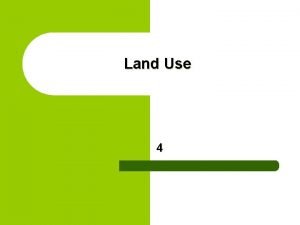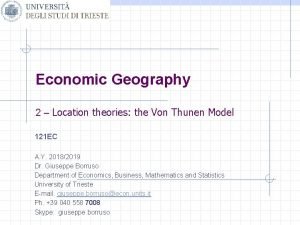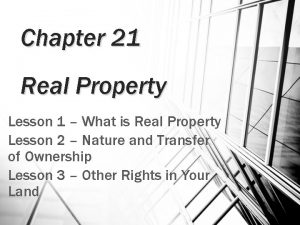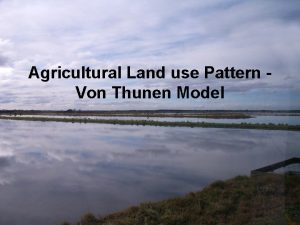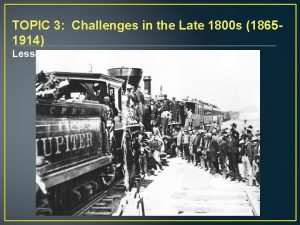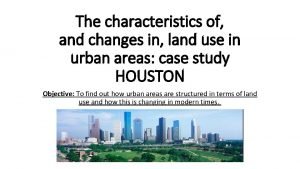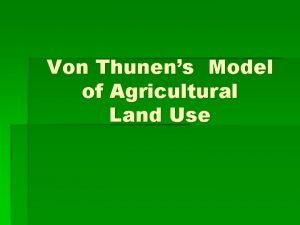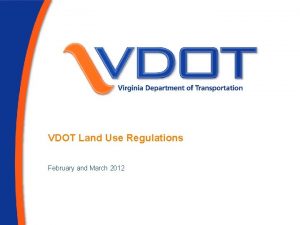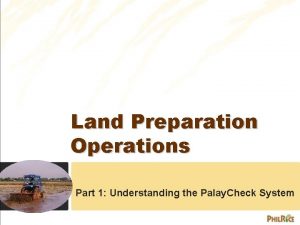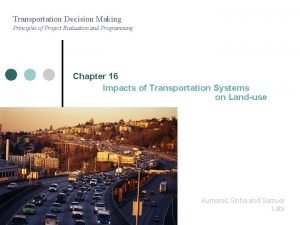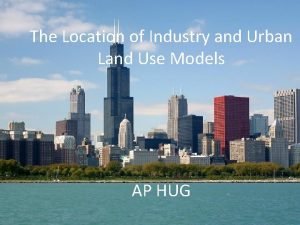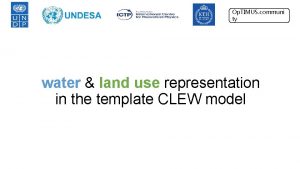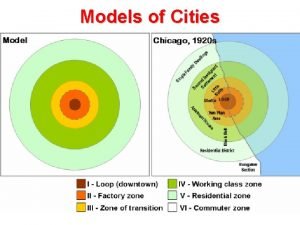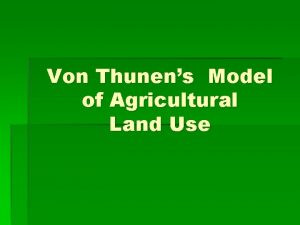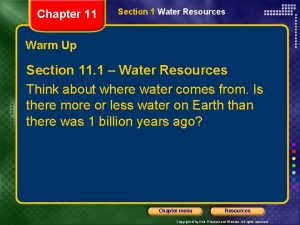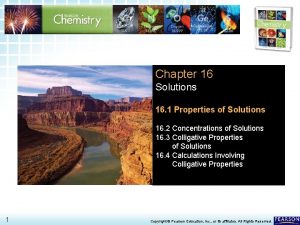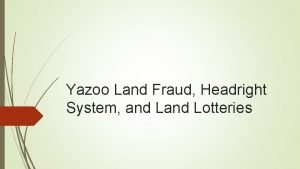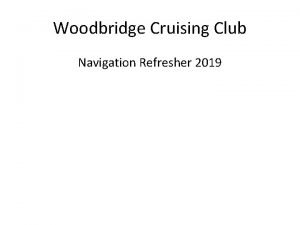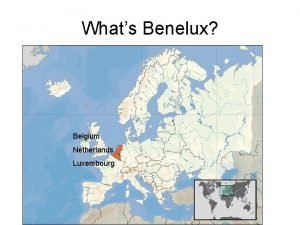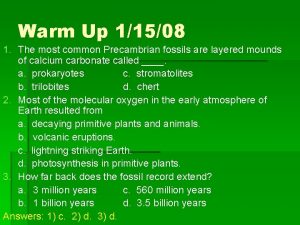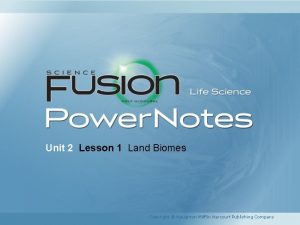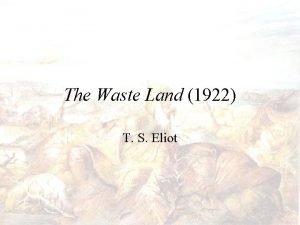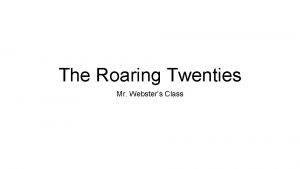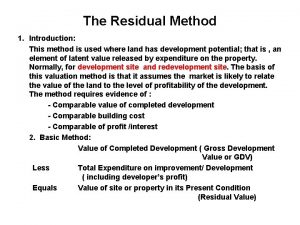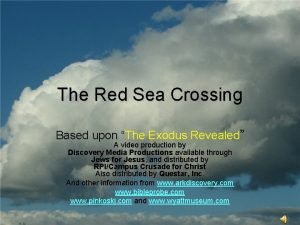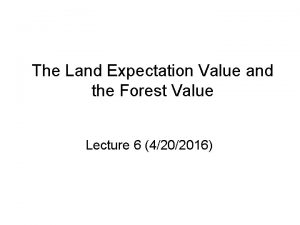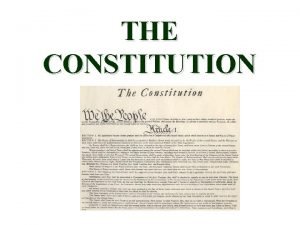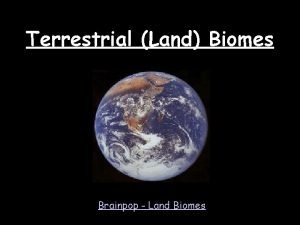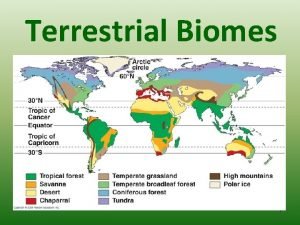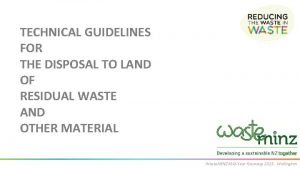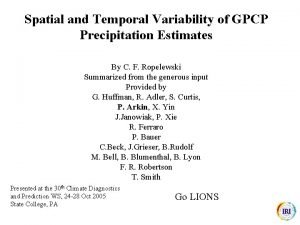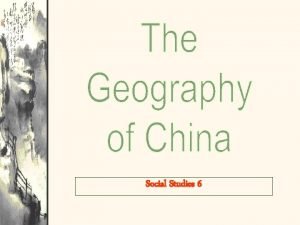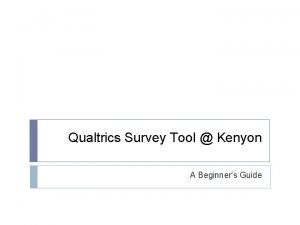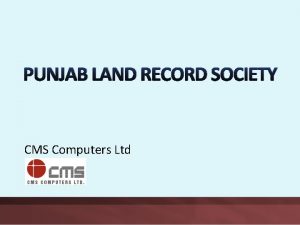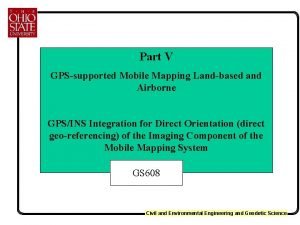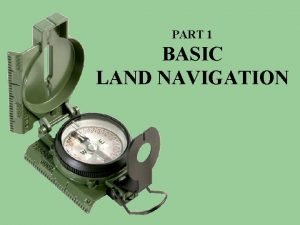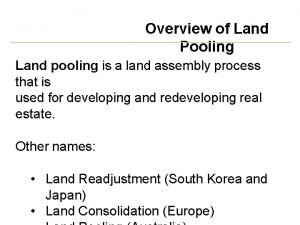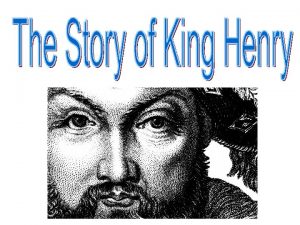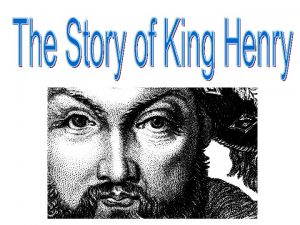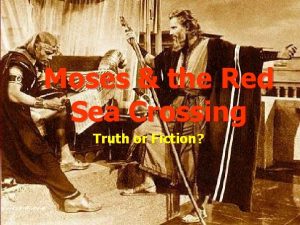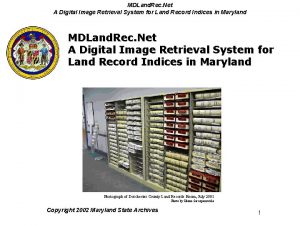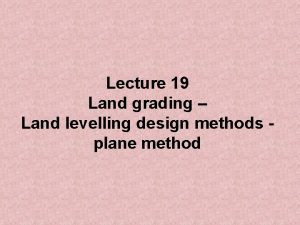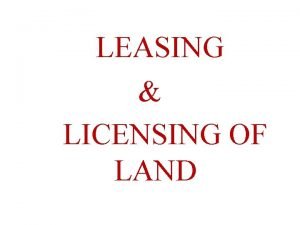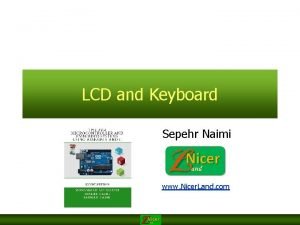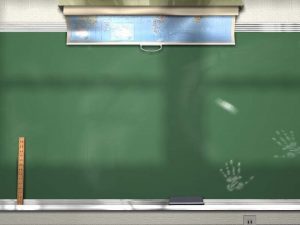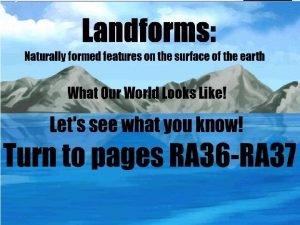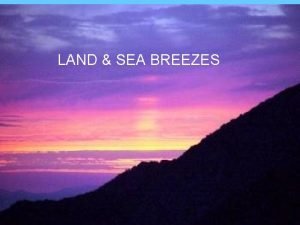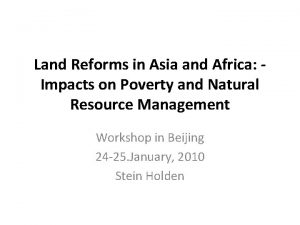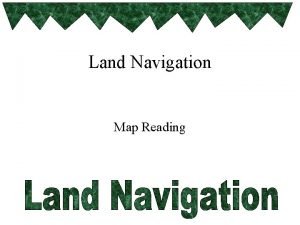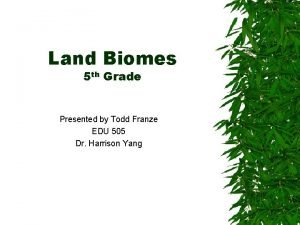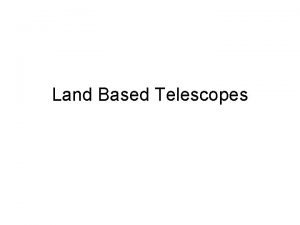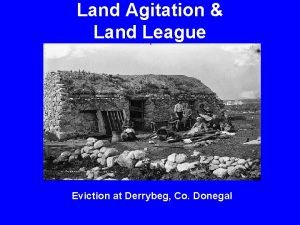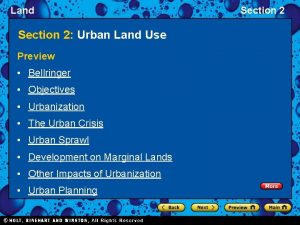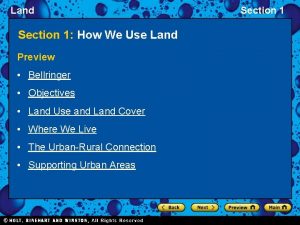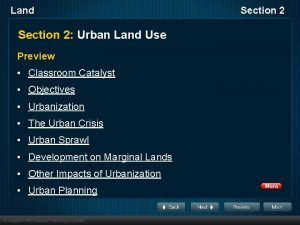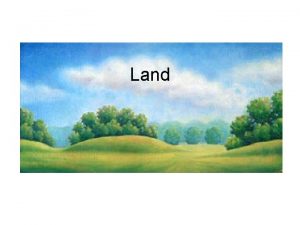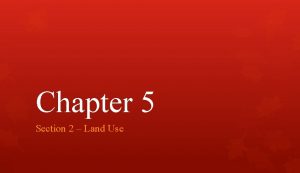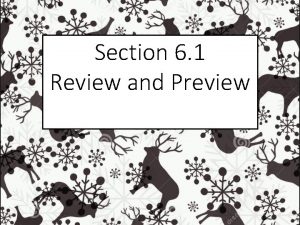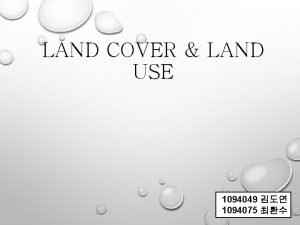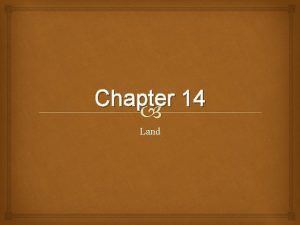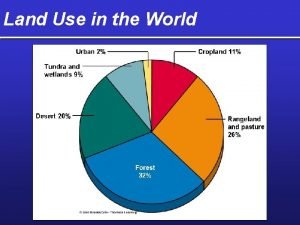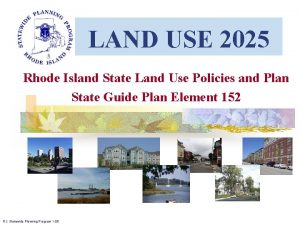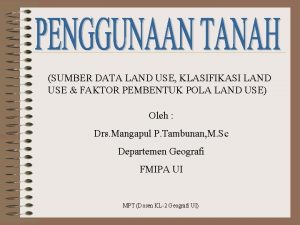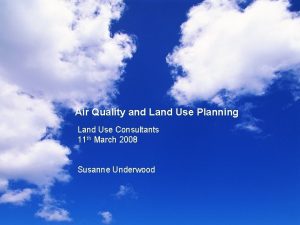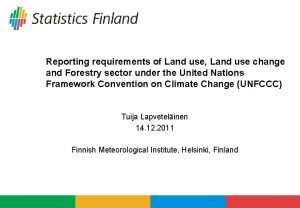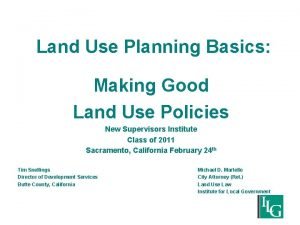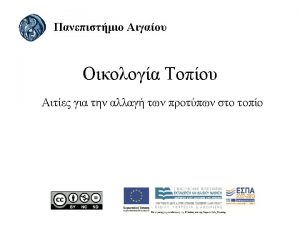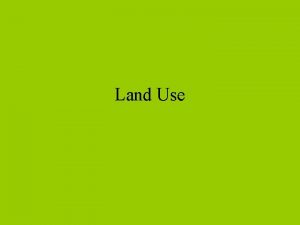Land Section 1 How We Use Land Preview



































































































































- Slides: 131

Land Section 1: How We Use Land Preview • Land Use and Land Cover • Where We Live • The Urban-Rural Connection • Supporting Urban Areas Section 1

Land Section 1 Bellringer • What percentage of people in the US live in cities? • What are some of the advantages of living in a city? • What are some disadvantages of living in a city?

Land Section 1 Objectives 1. Distinguish between urban and rural land. 2. Describe three major ways in which humans use land. 3. Explain the concept of ecosystem services.

Land Use • Has many purposes, including – farming, – mining, – building cities and highways, and – Recreation. Section 1

Land Section 1 Land Cover • Is what you find on a patch of land, • It often depends on how the land is used. • For example, – A forest, – a field of grain, – or a parking lot. • There are different types of land cover and different human uses for each cover type.

Land Use and Land Cover • What has the highest land use? • How much is used for cites? • How much is used for crops? • How much is used for raising livestock? Section 1

Urban • an area that contains a city, • an area that contains 2, 500 or more people and • usually has a governing body, such as a city council. •

Rural • an area of open land often used for farming, • or any population not classified as urban.

Land Section 1 Most land provides one or more resources that humans consume. Includes • wood in forests, • crops in farmland, and • mineral resources

Land Section 1 Where We Live • Until about 1850, most people lived in rural areas. – farmers, who grew crops and raised livestock. – Others managed the forests, – worked in local mines or mills, or – manufactured the necessities of life for the town.

Land Section 1 The Industrial Revolution • changed this pattern – machinery: fewer people to operate a farm or grain mill and – better transportation: allowed manufacturers to be further away • Thousands of rural jobs were eliminated, • Many people moved to cities to find jobs.

Land • Section 1 As a result, – people moved from rural to urban areas – urban areas grew rapidly during the 20 th century and – spread over more land. • Now, this movement is occurring rapidly in developing countries.

Today, most people throughout the world live in urban areas

The Urban-Rural Connection • Whether people live in cities or in the countryside, – people are dependent on resources produced in rural areas. •

Resources include: • • clean drinking water, fertile soil and land for crops, trees for wood and paper, and much of the oxygen we breath, which is produced by plants.

An ecosystem service is the role that organisms play in creating a healthful environment for humans.

Land The Urban-Rural Connection Section 1

Land Section 1 Supporting Urban Areas • The area of rural land needed to support one person depends on many factors, – climate, – the standard of living, and – how efficiently resources are used.

Supporting Urban Areas • Each person in a developed country – uses the ecosystem services provided by about 8 hectares of land.

But, many people in developing countries: • do not have access to all the resources for a healthy life, and • may use ecosystem services from less than one hectare of land.

Math Practice

Land Section 1 Review Section 14. 1

Land Section 1 Where do most Americans live? a. in urban areas b. on producing farms c. in rural areas d. There is an equal distribution of people across the land

Land Section 1 Which of the following is an example of how people use land? a. to harvest wood b. to preserve native species c. to grow crops d. All of the above

Land Section 1 The U. S. Census Bureau defines an urban area as an area that contains more than a. 250 people. b. 25, 000 people. c. 2, 500 people. d. 250, 000 people.

Land Section 1 Given that most people live in urban areas, why should rural areas be preserved? a. They provide crucial infrastructure. b. They contain greenbelts. c. They provide ecological services. d. None of the above

Land Section 1 Regardless of where people live, they are dependent on resources produced in a. rural areas. b. national parks. c. urban areas. d. wilderness areas.

Section 14. 1 Quick Check

Section 2: Urban Land Use Preview • Urbanization – The Urban Crisis – Urban Sprawl – Development on Marginal Lands – Other Impacts of Urbanization • Urban Planning • Intelligent Design • Transportation • Open Space • GIS Views of Seattle, Washington

Bellringer • Describe features that can make a city a pleasant place to live. • What features that can make a city an unpleasant place to live?

Land Section 1 Objectives 1. Describe the urban crisis, and explain what people are doing to deal with it. 2. Explain how urban sprawl affects the environment. 3. Explain how open spaces provide urban areas with environmental benefits. 4. Explain the heat-island effect. 5. Describe how people use the geographic information system as a tool for land-use planning.

Land Section 1 Urbanization • An increase in the ratio or density of people living in urban areas • People usually leave rural areas for more plentiful and better paying jobs in towns and cities.

Slow growing Urban areas: • are often relatively pleasant places to live, • Communities are built to handle growth – roads and public transportation • allowing traffic to flow freely. – Developed areas, mixed with green spaces provides • much needed ecosystem services – moderation of temperature, –infiltration of rainwater runoff, and – aesthetic value.

Land Section 1 The Urban Crisis • A rapidly growing population, – can overwhelm the infrastructure, – leading to • traffic jams, • substandard housing, and • polluted air and water.

Land Section 1 Infrastructure • basic facilities of a country or region, • such as – roads, bridges, railroads – Schools, gas stations, hospitals – Utilities: Water, sewers, electricity

Land Section 1 The Urban Crisis • When more people live in a city than its infrastructure can support, – the living conditions deteriorate. – has become so widespread throughout the world

Land Section 1

Land Urban Sprawl • the rapid spread of a city into adjoining suburbs & rural areas. Section 1

Land Section 1 Much of this growth results • building of suburbs, or housing and associated businesses on the boundary of a larger town.

Land Section 1

Land Section 1 Many of these suburbs are built on land that was previously used for food production.

Land Section 1 Development on Marginal Lands • Many cities were first built where there was little room for expansion. • As the cities grew, – suburbs were often built on marginal land, or land that is poorly suited for building. – Structures built on marginal land can become difficult or impossible to repair and can be expensive to insure.

Land Section 1 Development on Marginal Lands – For example, • Los Angeles was built in a basin, and has expanded onto slopes that are prone to landslides.

Land Section 1

Land Section 1 Other Impacts of Urbanization • Environmental conditions in the center of a city are different from those of the surrounding countryside, as cities both generate and trap more heat.

Land Section 1 Heat island • an area in which the air temperature is generally higher than the temperature of surrounding rural areas. • Heat is generated • by the infrastructure that makes a city run. • Roads and buildings • absorb and • retain heat longer then vegetation does.

Land Section 1 Heat Islands • The heat-island effect may be moderated by 1. planting trees for shade and 2. installing rooftops that reflect rather than retain heat.

Land Section 1 Heat Islands • can affect local weather patterns. – Hot air rises over a city, – cooling as it rises, and – eventually produces rain clouds. • In Atlanta, Georgia, and many other cities, increased rainfall is a side effect of the heat island effect.

Land Section 1 Urban Planning • Land-use planning – a set of policies and activities related to potential uses of land that is put in place before an area is developed. • The federal government – requires developers to prepare detailed reports assessing the environmental impact of many projects, • the public has a right to comment on these reports.

Land Section 1 Developers, city governments, local businesses, and citizens often disagree about land-use plans.

Land Section 1 Intelligent Design • Land-use planners use sophisticated methods and tools – A geographical information system (GIS) • automated system for capturing, storing, retrieving, analyzing, manipulating, and displaying geographic data.

Land Section 1 GIS software • Different types of data are entered about an area, such as the locations of sewer lines, roads, and parks, and then create maps with the data. • Each image corresponds to a different combination of information. • ** it allows a user to display layers of information about an area and to overlay these layers, like overhead transparencies, on top of one another.

Land GIS Views of Seattle, Washington Section 1

Land Section 1 Transportation • Most cities in the United States – are difficult to travel in without a car. – were constructed after the invention of the car. • Since availability of land was not a limiting issue, – Many cities sprawl over large areas.

By contrast, most cities in Europe were built before cars, and are compact with narrow roads.

Land Section 1 Transportation • In many cities, mass transit systems were constructed. • Mass Transit 1. 2. 3. 4. 5. uses buses & trains (moves many people at one time) saves energy, Limits the loss of land to roadways and parking lots, reduces highway congestion, reduces air pollution.

Where the construction of mass transit systems is not reasonable, carpooling is an important alternative.

Land Section 1 Open Space • land within urban areas - Greenbelts – set aside for scenic and recreational enjoyment. – has many environmental benefits & provides valuable functions. •

Land Open Space include 1. parks, 2. public gardens, and 3. bicycle and hiking trails. Section 1

Land Section 1 Open Space • The plants in open spaces – absorb CO 2, – produce O 2, – filter out ________from air and water, and – help keep a city ________in the summer. – can also reduce drainage problems by absorbing more of the rainwater runoff from building roofs, asphalt, and concrete resulting in less flooding.

Land Section 1 Open spaces These open spaces also proved urban dwellers with much-needed places for exercise and relaxation.

Land Review • Section 14. 2 Section 1

Land Section 1 Which of the following has not resulted from urban sprawl? a. suburbs b. loss of farmland c. overgrazing d. traffic congestion

Land Section 1 Which of the following is a side effect of heat islands? a. drought b. lower temperatures and drought c. lower temperatures d. increased precipitation

Land Section 1 Traffic jams, substandard housing, and polluted air and water can be caused by rapid growth in cities, a phenomenon known as a. urbanization. b. urban crisis. c. urban sprawl. d. infrastructure.

Land Section 1 An important environmental benefit of open spaces in cities includes a. contamination of water sources by runoff of soil and animal wastes. b. hotter, humid summers due to evaporation of water from plant leaves. c. the improvement in air quality resulting from filtering of pollutants by plants. d. All of the above

Land Section 1 Heat islands affect local a. weather patterns. c. traffic patterns. b. water levels. d. harvest patterns.

Land Section 1 Which of the following is true of land-use plans? a. Developers must prepare detailed reports assessing the environmental impact of their projects. b. The public often has input in land-use plans. c. Projects in environmentally sensitive areas may be hotly debated. d. All of the above

Land Section 1 An area prone to landslides is an example of a. rangeland. b. rural land. c. open space. d. marginal land.

Section 14. 2 Quick Check

Land Section 1 Section 3: Land Management and Conservation Preview • Farmlands • Rangelands – Problems on the Range – Maintaining the Range • Forest Lands – Harvesting Trees – Deforestation – Reforestation • Parks and Preserves – Wilderness – Benefits of Protected Areas – Threats to Protected Areas

Land Section 1 Bellringer 1. Why does the wilderness need to be preserved? 2. Why shouldn’t we consider the needs of humans first? 3. Why don’t we only consider our short-term needs and worry about the consequences later?

Land Section 1 Objectives 1. Explain the benefits of preserving farmland. 2. Describe two ways that rangeland can be managed sustainably. 3. Describe the environmental effects of deforestation. 4. Explain the function of parks and of wilderness areas.

Land Management • The main categories of rural land – farmland, – rangeland, – forest land, – national and state parks, and – wilderness. Section 1

Land Section 1 Rural Lands • sometimes these lands are managed sustainably so that they will provide resources indefinitely. • sometimes their productivity is reduced by overusing or polluting them. • The condition of rural land is important because of the ecological services that it provides.

Land Section 1 Farmlands • land that is used to grow crops and fruit. • The U. S. contains more than 100 million hectares of prime farmland. • In some places, urban development threatens some of the most productive farmland.

Land Section 1 National Farmland Protection Program • Established in 1996 by the U. S. government • To help state, county, and local governments protect farmland in danger of being paved over or otherwise developed.

Land Section 1 Rangelands • Land that supports different vegetation types like – grasslands, – shrublands, and – deserts and – that is not used for farming or timber production.

Land Section 1 Rangelands • can be arid, like the rangelands in the desert Southwest, or • relatively wet, like the rangelands of Florida. • The most common human use grazing of livestock.

Land Section 1 Rangelands • Common livestock – Cattle, sheep, and goats – are valued for their meat, milk, wool, and hides. • Native wildlife also graze these lands. • Essential for maintaining the world’s food supply.

Land Section 1 World population growth may require a 40 percent increase in the food production of rangeland from 1977 to 2030.

Land Section 1 Problems on the Range • Overgrazing – the depletion of vegetation due to the continuous feeding of too many animals. – results in changes in the plant community. – Less desirable plants may • invade the area and • replace more-desirable plant species.

Land Section 1 In cases of severe overgrazing, all the vegetation that covers the land is eaten. Once the plants are gone, there is nothing to keep the soil from eroding.

Land Section 1 Maintaining the Range • Much of the rangeland in the U. S. – is public land – managed by the federal government, • which leases the rangeland to ranchers. – However, much of the rangeland in the U. S. is degraded.

Land Section 1 The Public Rangelands Improvement Act of 1978 • Enacted to reverse this trend and improve land management practices. • Sustaining the productivity of rangeland generally means: – reducing overgrazing by limiting herds to sizes that do not degrade the land.

Land Section 1 Improving rangeland that has been degraded • Methods used to help improve 1. killing invasive plants, 2. planting native vegetation, and 3. fencing areas to let them recover to the state they were in before they were overgrazed so that the vegetation can recover.

Land Section 1 Ranchers • also control grazing by digging many small water holes so that the vegetation around a single water hole is not overgrazed.

Land Forest Lands • Trees are harvested to provide products – paper, – furniture, and – Lumber and plywood for our homes. – Fruit – Maple syrup and turpentine. Section 1

Land Section 1 There are many ecosystem services provided by forests. However, one of the most important is the removal of CO 2 from the air.

Land Section 1 Harvesting Trees • People use enormous amounts of wood. – The worldwide average is 1, 800 cm 3 of wood/person/ day. – In the US, average person uses about 3. 5 times this amount.

Land Section 1 About 1. 5 billion people in developing countries depend on firewood as their main source of fuel.

Land Section 1 Harvesting Trees • The timber industry classifies forest lands into three categories: 1. Virgin forests: forests that have never been cut. 2. Native forests: forests that are planted and managed. 3. Tree farms: areas where trees are planted in rows and harvested like other crops.

Land Section 1 The two most widely used methods of harvesting trees are 1. clear-cutting and 2. selective cutting.

Land Section 1 Harvesting Trees • Clear-cutting is the process of removing all of the trees from and area of land. Clear-cutting large areas destroys wildlife habitat and causes soil erosion. • Selective cutting is the process of cutting and removing only middle-aged or mature trees. It is more expensive than clear-cutting, but is usually much less destructive. It is usually practiced on smaller areas owned by individuals.

Land Harvesting Trees Section 1

Land Section 1 Deforestation • the process of clearing forests. • Most countries – become severely deforested as populations • expand • the demand forest products increases.

Land Forests • are cleared to convert the land into farmland, and • to make space for roads, homes, factories, and office buildings. Section 1

Land Section 1 Deforestation • reduces wildlife habitat, but it has other impacts, too. • For example, when forests are cleared from hillsides – soil erosion usually results if the area is not quickly planted with a cover crop. – Without tree roots to hold the soil in place, it is easily washed or blown away into the valley below.

Land Section 1 The rate of deforestation • Especially high in tropical rain forests, where the soil is relatively thin. • Farmers who clear forests in these areas must always move from one plot of land to another, clearing more forest land each time.

Land Section 1 Reforestation • the reestablishment and development of trees in a forest land. • In some places, reforestation is happening faster than trees are being cut down.

Land Section 1 The price of deforestation, which causes soil erosion, landslides, and flooding, is sometimes too high, so in some areas the forest has been allowed to regenerate or has been replanted.

Land Section 1 Reforestation • Some governments require reforestation after timber has been harvested from public land. • However, worldwide, more than 90 percent of all timber comes from forests that are not managed • Many governments are currently working to improve reforestation efforts and to promote less destructive methods. • Private organizations have established treeplanting programs on roadsides and in cities.

Land Section 1 Parks and Preserves • In the 1870 s, a group of explorers approached Congress with news of a magnificent expanse of land in Wyoming and Montana they believed would be damaged by the development that had changed the northeastern United States. • Congress agreed to protect this land by setting it aside for the public to use and enjoy, and the first national park, Yellowstone, was created. • Today, the U. S. has about 50 national parks.

Land Parks and Preserves Section 1

Land Section 1 Parks and Preserves • Most public lands – are not as protected as the national parks are. – Some lands are leased to private companies for logging, mining, and ranching. – Others are maintained for hunting, fishing, wild-life refuges, or to protect endangered species.

Land Section 1 Biosphere Program • International efforts • Has set up several hundred preserves, – called biosphere reserves, – include people in the management plan of the reserves.

Land Parks and Preserves 1. Where is the reserve’s research station located? 2. Why has it been placed there rather than anywhere else in the reserve? 3. What indicators can you see that this reserve might be an ecotourism destination? 4. What does the map tell you about the function of buffer zone 2? Section 1

Land Section 1 Wilderness • A region that is not cultivated and that is not inhabited by humans.

Land Section 1 The U. S. Wilderness Act, - 1964, • Designated certain lands as wilderness areas. • So far, – 474 regions – covering 32 million acres – These areas are open to hiking, fishing, and camping. • Building roads or structures and using motorized equipment is not allowed in wilderness areas.

Land Section 1 Benefits of Protected Areas • Protected areas – often provide the only place where unspoiled forests, deserts, or prairies remain. – also provide recreation, such as hiking and camping, for many people. • Without these areas, – the plants and animals that can survive only in these ecosystems would disappear.

Land Section 1 Benefits of Protected Areas • Wilderness areas – serve as outdoor classrooms and – research labs where people can learn more about the natural world.

Land Section 1 Threats to Protects Areas • Around the world, – more people visit national parks and wilderness areas each year and – leave their mark on the land. – Litter and traffic jams now plague many of our national parks.

Land Section 1 Threats to Protects Areas • Rangelands, Are often close • mining and logging sites, enough to affect the parks • oil and gas operations, • power plants, and • urban areas

Land Section 1 In addition, preserved areas are affected by climate change and by air and water pollution, as are most other parts of the world.

Land Section 1 Threats to Protect Areas • In attempts to protect wilderness from damage, – limits have been set in some areas • the number of people permitted in the area at any given time. – Some areas are completely closed to visitors to allow wild animals to breed.

Land Threats to Protect Areas • Volunteer programs – are now active in many wilderness areas. – help pick up trash, – build trails, – control invading or – exotic species, and – help educate the visiting public. Section 1

Land Graphic Organizer Section 1

Land Quick LAB Section 1

Land Section 1 Review Section 14. 3

Land Section 1 Which of the following is not an environmental effect of deforestation? a. reduction of wildlife habitat b. loss of topsoil c. soil erosion d. re-establishment of trees

Land Section 1 The National Farmland Protection Program was designed to _______ a. protect farmland from being overtaken by natural grasses and weeds. b. Protect farmland from damage by wild grazing animals that are destroying crops. c. protect farmland from being developed. d. protect farmland from environmental damage from pollution.

Land Section 1 Which of the following most effectively allows forests to recover from tree harvesting? a. cutting only medium-sized or mature trees b. cutting all of the trees and then replanting the area with seedlings c. allowing the forest to reseed itself d. cutting only young trees and then replacing them with seedlings

Land Section 1 Eliminating invasive plants and replacing them with native plants is one aspect of ____ a. urban management. c. range improvement. b. deforestation. d. overgrazing.

Land Section 1 What can be done to sustain the productivity of rangeland? a. Limit herd size. c. Leave the land unused for a time. b. Eliminate invasive plants. d. All of the above

Land Section 1 Which of the following statements about tree harvesting methods is correct? a. Clear-cutting is quick but is more expensive than other methods due to the vast areas involved. b. Selective cutting eliminates the possibility of soil erosion. c. Clear-cutting requires the most road building due to the large number of trees harvested. d. Selective cutting minimizes the impact on forest ecosystems.

Land Section 1 In 1870, the first national park established to protect and preserve the land for future generations was a. Grand Canyon. c. Yellowstone. b. Yosemite. d. Death Valley.

Land Section 1 The designation of wilderness areas a. guarantees unrestricted public access. b. historically forbade mining. c. allows only limited development. d. provides for protected habitats.

Land Section 1 Environmental damage to wilderness areas ______ a. is partly the result of ranching activities. b. has yet to attract widespread attention. c. may worsen as the U. S. population grows. d. is not related to pollution from urban areas.

Land Section 1 Why is it important to preserve farmland? a. Farmland provides an important oxygen source for urban areas. b. Farmland moderates the temperature of urban areas. c. Farmland provides crops and fruits to support urban and rural populations. d. All of the above

Land Section 1 What is reforestation? a. removing all trees from an area b. replanting trees in an area c. removing selected trees from an area d. None of the above

Land Section 14. 3 Quick Check
 Example of a thesis statement
Example of a thesis statement Summary thesis statement
Summary thesis statement Test prep preview
Test prep preview Test prep preview
Test prep preview Test prep preview
Test prep preview Test prep preview
Test prep preview Sccm technical preview
Sccm technical preview Preview statement speech example
Preview statement speech example What is a preview statement
What is a preview statement Test prep preview
Test prep preview Nnn preview
Nnn preview The selection preview
The selection preview Chapter 21 standardized test practice answers
Chapter 21 standardized test practice answers The four agreements preview
The four agreements preview Test prep preview
Test prep preview Line between pada perintah column digunakan untuk membuat
Line between pada perintah column digunakan untuk membuat Classic trio' of selection techniques
Classic trio' of selection techniques Test prep preview
Test prep preview Disadvantages of skimming in reading
Disadvantages of skimming in reading 1984 book preview
1984 book preview Yandex.ru video
Yandex.ru video Nút lệnh print preview nằm ở đâu
Nút lệnh print preview nằm ở đâu Tams dallas
Tams dallas Review and preview
Review and preview Benefits of hr forecasting
Benefits of hr forecasting Disadvantages of realistic job preview
Disadvantages of realistic job preview Multi-channeled definition in communication
Multi-channeled definition in communication Preview speech
Preview speech Verbal intercultural communication
Verbal intercultural communication Nnn image preview
Nnn image preview Fungsi movie task pane
Fungsi movie task pane What are landforms
What are landforms What are landforms
What are landforms Rodhocetus
Rodhocetus Hoyt model
Hoyt model City zones
City zones St. marys county land use and zoning lawyer
St. marys county land use and zoning lawyer Land use planning lecture notes
Land use planning lecture notes Hmda dpms
Hmda dpms Usgs land use classification
Usgs land use classification Types of land use
Types of land use Mixed land use ap human geography definition
Mixed land use ap human geography definition Bid-rent theory
Bid-rent theory Irrevocable rights to some limited use of another's land
Irrevocable rights to some limited use of another's land Von thunen's agricultural land use model
Von thunen's agricultural land use model What contribution did mexicans make to cattle ranching
What contribution did mexicans make to cattle ranching Characteristics of land use in urban areas
Characteristics of land use in urban areas Land use planning lecture notes
Land use planning lecture notes Flood hazard area land use management guidelines
Flood hazard area land use management guidelines Six assumptions of von thunen model
Six assumptions of von thunen model Vdot land use permit
Vdot land use permit Land use planning '' lecture notes
Land use planning '' lecture notes Wetland tillage
Wetland tillage Land use transportation
Land use transportation Multiple nuclei model ap human geography
Multiple nuclei model ap human geography թիմուս
թիմուս Burgess's concentric zone model
Burgess's concentric zone model Define land use planning
Define land use planning Multiple nuclei model
Multiple nuclei model Von thunen six assumptions
Von thunen six assumptions Chapter 14 land section 1
Chapter 14 land section 1 Yesterday
Yesterday Chapter 11 section 3 water pollution answer key
Chapter 11 section 3 water pollution answer key Chapter 16 solutions answer key
Chapter 16 solutions answer key Ratio and proportion for use after section 7-2
Ratio and proportion for use after section 7-2 What line types are usually omitted from sectional views
What line types are usually omitted from sectional views Revolves section
Revolves section Half vier
Half vier Chemical potential energy images
Chemical potential energy images Chapter 10 section 1 meiosis
Chapter 10 section 1 meiosis Yazoo land fraud cartoon
Yazoo land fraud cartoon Woodbridge cruising club
Woodbridge cruising club Types of wind
Types of wind Benelux land
Benelux land What allowed amphibians to flourish on land
What allowed amphibians to flourish on land Lesson 1 land biomes answer key
Lesson 1 land biomes answer key Heritage marina
Heritage marina The waste land summary
The waste land summary Florida land boom of the 1920s
Florida land boom of the 1920s Residual method of valuation example
Residual method of valuation example How wide was the red sea crossing
How wide was the red sea crossing Circe land
Circe land Columbus
Columbus Chapter 24 the land where continents collided
Chapter 24 the land where continents collided Land expectation value calculator
Land expectation value calculator R.land
R.land Supreme law of the land clipart
Supreme law of the land clipart Florida cession date acquired
Florida cession date acquired Brain pop biomes
Brain pop biomes Land biomes brainpop answers
Land biomes brainpop answers Land based telescope
Land based telescope Technical guidelines for disposal to land
Technical guidelines for disposal to land Gpcp
Gpcp Shabdong
Shabdong Grösstes land der welt
Grösstes land der welt Peace bread and land
Peace bread and land Rips through his life
Rips through his life Land surveyor kenyon
Land surveyor kenyon Plrs fard
Plrs fard 2 causes of soil pollution
2 causes of soil pollution Soil pollution images diagram
Soil pollution images diagram Philippines national anthem
Philippines national anthem Pga vs lga
Pga vs lga Pflegeberatung linz-land
Pflegeberatung linz-land Prava suites
Prava suites Gojiland
Gojiland Land-based mobile mapping
Land-based mobile mapping Part 4
Part 4 Spur land nav
Spur land nav Land befor
Land befor Mnumonic
Mnumonic King henry chocolate milk story
King henry chocolate milk story Gulf of aqaba chariot wheels
Gulf of aqaba chariot wheels Mdlandrecs
Mdlandrecs Land levelling methods
Land levelling methods Railway land license fee
Railway land license fee Grass grows hans haacke
Grass grows hans haacke Nicerland
Nicerland Land
Land High area of flat grassy land
High area of flat grassy land Land with steep sides that rises sharply
Land with steep sides that rises sharply Land ska med lag byggas
Land ska med lag byggas Land and sea breeze animation
Land and sea breeze animation Land reform definition
Land reform definition Land tenure reform law
Land tenure reform law Basic map reading and land navigation
Basic map reading and land navigation Maritime and land based empires differences
Maritime and land based empires differences Land biomes brainpop answers
Land biomes brainpop answers Land based telescopes
Land based telescopes Land art prezentace
Land art prezentace Land agitation
Land agitation Land of letters in kerala
Land of letters in kerala
